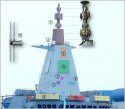There seems to be some criticism of the Type 055 design. The low position of the radar panels effect the detection range and the upper decks seems to be made up of light aluminum alloys that can be easily damaged during combat. This comes from a Macau based military analyst Anthony Wong Dong.
The radar horizon gain from raising a shipborne radar higher is negligible under any sane set of assumptions. I don't know precisely how high above the waterline a Type 055's radar is (or even which of the radars he's talking about), but let's call it 25m. Let's say, for
a fortiori argument's sake, than another ship's radar is 50m above the waterline. Let's assume further that both ships are scanning for targets flying at an altitude of 10km. More realistic numbers would be welcome here.
Do you know what gain in spotting distance the latter radar gets over the former? Less than 2%. Which also means a less than 4% gain in search area. This is militarily insignificant.
As for the aluminium alloy, that's what advanced warships are made out of (including those in the USN). The
Zumwalt's superstructure is made out of resin-infused wood. It's not clear that steel can take a Mach 4 missile hit any better than aluminium or wood. A modern warship utilizes active defences (missiles and bullets), not an armoured hull.
Word to the wise: any time you see an article on the Chinese military with the terms "Anthony Wong Dong", "Minnie Chan", or "Kanwa", click that little x in your browser tab.




